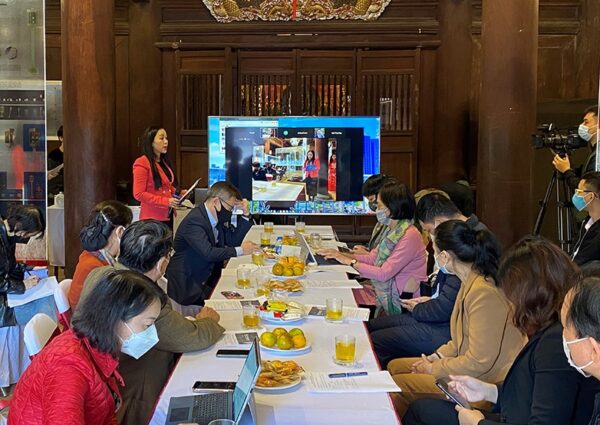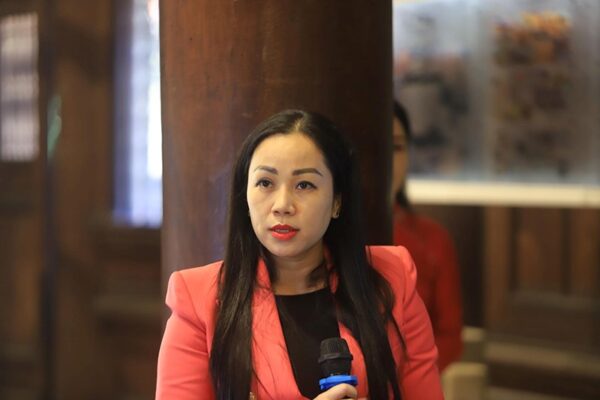
The workshop aims to exchange, discuss and share experiences on the Action Plan and mechanisms and policies of Hanoi city.
The workshop “Creative Design from the Capital’s Cultural Resources” is within the framework of Vietnam Design Week 2021 to exchange, discuss and share experiences on the City’s Action Plans and policies of Hanoi city, with the participation of prestigious experts, international organizations, investors, businesses, representatives of cultural creative spaces and a number of universities in the capital area.
The “UNESCO Creative Cities” Network was established in 2004 to promote international cooperation among the honored cities with cultural resources and cultural creativity as the foundation for urban development in a sustainable way. In October 2019, 20 years since Hanoi was honored as a UNESCO City of Peace, Hanoi officially became a member of UNESCO’s Global Network of Creative Cities with the title of Creative City of Design. Through participating in the Network, cities commit to sharing their best practices and developing public-private partnerships and civil society organizations.
Speaking at the workshop, Deputy Director of Hanoi Department of Culture and Sports, Ms. Pham Thi My Hoa affirmed: Following the commitment with UNESCO after Hanoi officially becomes a Creative City in the field of design, Hanoi will be concretized by long-term programs and action plans on the vision and linkages of the City’s policies, creating favorable conditions to promote the field of creative design, as well as raise awareness, connect the community to gradually realize initiatives and build the image of Hanoi – Creative City. “Joining UNESCO’s network of creative cities is the first but very important step towards the goal of enhancing its status and creating a new and more attractive image for Hanoi. The road ahead requires great efforts of the City, from all levels, branches and localities, especially the role of each citizen of the Capital. Through this workshop, Hanoi wishes to continue to receive the attention and companionship of all stakeholders to realize the vision, for the goals of sustainable development” – Ms. Pham Thi My Hoa emphasized.

Deputy Director of Hanoi Department of Culture and Sports, Ms. Pham Thi My Hoa spoke at the seminar.
With active contributions in the process of consulting and policy-making on cultural industry development; in which, there are a number of research results that have been applied in realizing construction solutions for Hanoi – a creatively designed city belonging to the Unesco creative cities network, forming a mechanism to transform cultural resources into cultural soft power through the development of cultural industries, Assoc. Prof. Dr. Nguyen Thi Thu Phuong – Deputy Director in charge of the Vietnam National Institute of Culture and Arts Studies gave many opinions on realizing action initiatives of Hanoi – The Creative Design City of UNESCO’s Creative Cities Network.
According to Assoc. Prof. Dr. Nguyen Thi Thu Phuong, the policies of Hanoi city over the past time have initially created an institutional framework which is capable of promoting 8 pillars of cultural resources such as tangible cultural heritage, intangible cultural heritage, natural heritage, diverse cultural products and services, etc. Although a mechanism for transformation has not been created yet, public-private organizations and research units have created the impetus for Hanoi’s transformation in the field of design, have contributed significantly to the regeneration and awakening of cultural resources creating the development of industrial products and services.
Assoc. Prof. Dr. Nguyen Thi Thu Phuong said that Hanoi needs to create a connection between tradition and modernity in cultural industrial products, create a mechanism for financial investment and capital attraction, and form an environment that promotes economic innovation, investment in the development of science and technology infrastructure, drastic implementation of 6 action initiatives Hanoi has committed to the UNESCO Creative Cities Network.
According to Assoc. Prof. Dr. Dang Van Bai – Vice Chairman of the National Council of Cultural Heritage of Vietnam; Vice Chairman of the Vietnam Cultural Heritage Association, in the world, there are very few capitals and cities with a long history of formation and development like Thang Long – Dong Do – Hanoi. With 5922 historical and cultural relics, 1793 intangible cultural heritages and 1350 craft villages and craft villages, Hanoi ranks first in the country in terms of the number of cultural heritages, many of which are tourist attractions. strongly attract domestic and foreign tourists. These heritages have been, are and will become a significant resource, a cultural heritage resource for the development of creative spaces of the capital, creating great potentials in the development of Hanoi’s cultural industry.
According to Mr. Le Quoc Vinh, Chairman of the Board of Directors and General Director of Le Media Group, with the title of Creative City, Hanoi needs a large-scale creative center, where there is an entertainment space, utilities, a technology platform for everyone to cooperate, share creativity, introduce products, find investment partners. In particular, Hanoi needs to promote public-private partnership, attract private entities to invest in works serving culture and cultural industries.
The workshop heard delegates mention cultural resources, the exploitation of resources for creative design, solutions to promote the development of Creative City, realizing initiatives when Hanoi participates in the UNESCO’s Creative Cities Network and Hanoi’s mechanisms and policies to make the action plan highly effective.
Hong Dien
